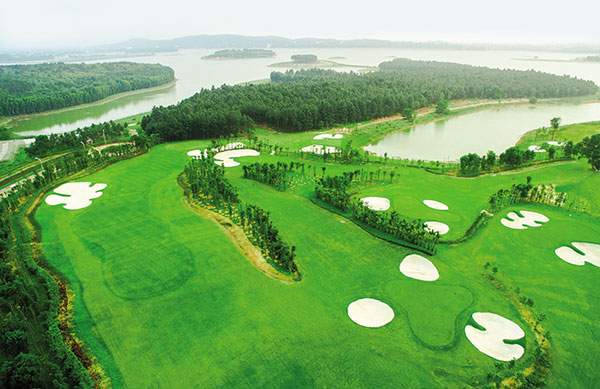With booming golf resort development across the country, Vietnam has come a world-class destination for golf tourism.
Despite a rocky start, the golf industry in Vietnam has become big business
Nguyen Van Minh, a 45-year resident in Hanoi, is planning to start playing golf soon after months of consideration.
“In the past, golf was a luxurious sport, but now it has become a popular and favoured sport among Vietnamese like me thanks to rising incomes, more leisure time, and easier means of transport,” Minh said.
Like Minh, many of his friends are now members of golf clubs. Golf is an increasingly attractive sport in many parts of Vietnam, regardless of a fall in golf’s popularity in other international markets.
“Reductions in golfers will generally occur in well-established markets, where trends change and people have many recreational activities on offer to choose from. Vietnam goes against this trend as the game is still growing here both domestically and as a destination for inbound golf tourism,” Timothy Kevin Haddon, general manager of the Ba Na Hills Golf Club, told VIR.
Echoing Haddon’s view, David Hill, general manager of the 100 per cent foreign-owned The Dàlat at 120, said “Vietnam has a strong domestic market to utilise golf courses in major cities, and this can be witnessed by the creation of night time golf at an increasing number of courses to extend the business day. This will also allow players to enjoy this wonderful game in cooler temperatures in the low land courses.”
Golf has become a lucrative component of Vietnam’s tourism industry. According to Hill, Vietnam is well placed to benefit from increased inbound golf business. Traditional strong markets like Thailand and Malaysia are established, and golfers are now looking at combining destinations for multiple courses.
This provides Vietnam with an opportunity to provide – through direct connections to other major cities in the region – a second set of courses in Ho Chi Minh City, Hanoi, Danang, and Dalat, connecting, for example, to courses in Thailand, Malaysia, or Singapore.
“Golf tourism is booming, particularly in the Danang region. With all the new golf courses being built, this country has without question become a world-class destination for golf,” said Evans Mahoney, director of golf at the BRG Kings Island Golf Resort.
Seeing huge potential, investors have built costly integrated resorts with world-class golf courses throughout the country in the past years to tap into the trend.
Golf courses are now scattered through the country, and they carry the endorsements of legends such as Jack Nicklaus, at the BRG Legend Hill Golf Resort near Hanoi; Greg Norman, at The Bluffs Ho Tram Strip near Ho Chi Minh City; and Nick Faldo, at the Laguna Lang Co integrated resort in the centre of the country.
In addition to these, the number of Vietnamese-owned, integrated golf resorts has increased, with more influential Vietnamese property developers joining the trend.
“I think the government has approved plans for 99 or 100 courses by 2020 or [thereabouts]. In order to accommodate players coming into the country and the growing domestic market we need more golf courses. The current number of 40 courses just isn’t enough to host everyone,” Mahoney said.
Local investors in the lead
Around 2010, the majority of golf courses in Vietnam were owned by foreign investors. However, the situation has changed in recent years as many more Vietnamese enterprises have joined the industry.
Industry insiders said that at the time, many foreign golf course investors found difficulties in operating their businesses effectively, because of the formerly small number of golfers and the gloomy real estate market.
Among the 28 operational golf courses with 18 holes or more, less than 10 courses – those located in cities and vacation destinations like Ho Chi Minh City, Danang, Hanoi, Haiphong, and Quang Ninh – broke even or made a small profit.
According to the Vietnam Golf Association (VGA), a hole carries at least a $1 million investment, excluding land rentals and site clearance. Thus, the investor of an 18-hole golf course in Vietnam could only get an investment return when a course hosts at least 30,000 players a year. To get a 10 per cent profit, it must have 33,000 players a year.
Several investors earlier said that, although the fees for golf club members and other annual service fees were relatively expensive, they were not able to make back their investment in the first years of operation.
In spite of that, the involvement of Vietnamese firms in the golf course business has created a new dynamic, as many have met with great success.
According to Vingroup’s financial statement in the third quarter of 2016, the giant property developer made a net revenue of VND10.65 trillion ($484.09 million), up 47 per cent on- year. This impressive result was attributed to contributions of integrated golf resorts in Ha Long, Nha Trang, and Phu Quoc.
Since opening the first golf-integrated resort – the Vinpearl Resort Nha Trang in 2003 – Vingroup has opened many more, including the Vinpearl Phu Quoc Resort & Golf and the Vinpearl Luxury Nha Trang.
The other senior player is FLC Group – the operator of integrated golf resorts such as the FLC Sam Son Beach & Golf Resort and the FLC Quy Nhon Resort & Golf – which announced a net revenue of over VND4.75 trillion ($215.9 million) in the first nine months of 2016, up 40 per cent on-year.
The good performance of integrated golf resorts was attributed to the recovery of the real estate market and a strong growth in international tourist arrivals.
Vietnam attracted more than 10 million international tourist arrivals in 2016, up 26 per cent on-year, while the number of domestic travellers hit 62 million, according to the Vietnam National Administration of Tourism.
Noticing the impressive golf business growth of firms like Vingroup, other realty developers are not sitting still. In the past two years, the property market witnessed the resort segment entry of newcomers like Sun Group, BIM Group, Empire Group, Eurowindow Holdings, CEO Group, and LDG Group.
In March 2016, Sun Group opened the Ba Na Hills Golf Club in the central city of Danang.
The Ba Na Hills Golf Club is the first in Sun Group’s chain of golf courses to be constructed throughout the country. The second phase of the golf course will be completed at the end of 2018.
Along with domestic firms, foreign investors are also optimistic about the bright future of the integrated golf resort segment.
As the first and largest world-class integrated resort in Vietnam – and an appealing second home destination – Singapore’s Banyan Tree-invested Laguna Lang Co is planning the expansion of its golf component.
“Our expansion plans of the destination focus on our existing course. We wish to supplement the challenging aspects of the course with short holes and unique individual holes in and around the Laguna Lang Co integrated resort, so that golf is a genuine part of the DNA of our entire resort,” Gavin Herholdt, managing director of Laguna Lang Co, told VIR.
“We would like the neighbouring area around our resort to accommodate another two courses and are hopeful of working with other parties to bring this to fruition,” he added.
VinaCapital and Golf Yield Enterprises began construction on the $4 billion Nam Hoi An resort project in April 2016, after years of delays.
“We are strongly interested in the project. Despite the economic woes of 2008-2012, we are still committed to developing the project,” said Don Lam, general director of VinaCapital.
Besides the traditional destinations of Phu Quoc and Nha Trang, a remarkable trend in the industry in recent years has been the appearance of golf resort projects in cities and provinces where there had been none. Places such as Danang, Thanh Hoa, Ha Long, Haiphong, Binh Dinh, Lao Cai, and Vinh Phuc now host such high-end projects as the FLC Quy Nhon Beach & Golf Resort and the Vinpearl Ha Long Bay Resort.
Policy reform is in the pipeline
The Ministry of Planning and Investment (MPI) is seeking comments from relevant ministries for its proposal on applying conditions for golf course business and investment to ensure sustainable and effective operations.
To this end, the MPI is proposing removing Decision No. 1946/QD-TTg of November 2009, covering national golf course development to 2020, thus enabling to shift to state management based on business conditions instead of on planning as the current.
The application of conditions for golf course business and investment activities conforms to the Investment Law of 2014, which states that golf course is a conditional business.
According to the MPI, although Decision 1946 has helped restrain the rampant development of golf courses and increase their operational efficiency, management of golf course investment and business activities have proven problematic.
For example, the locations and investment scales of some golf courses listed in the planning are no longer realistic, not factoring in the specific development conditions of each locality or market demand. The difficulty of on-the-fly adjustments contributes to a lack of sustainability and efficiency.
Decision 1946 also includes specific sanctions regarding the responsibilities of investors in golf course construction. Many failed to meet their agreed-upon schedules, leading to a waste of land resources and public indignation.
“The application of golf course business conditions will increase transparency and remove “ask-give” mechanism in the industry,” said a senior MPI official.
VIR
Bich Thuy
The article "Golf returns drive developer interest" was originally published on http://english.vietnamnet.vn/fms/business/177729/golf-returns-drive-developer-interest.html





